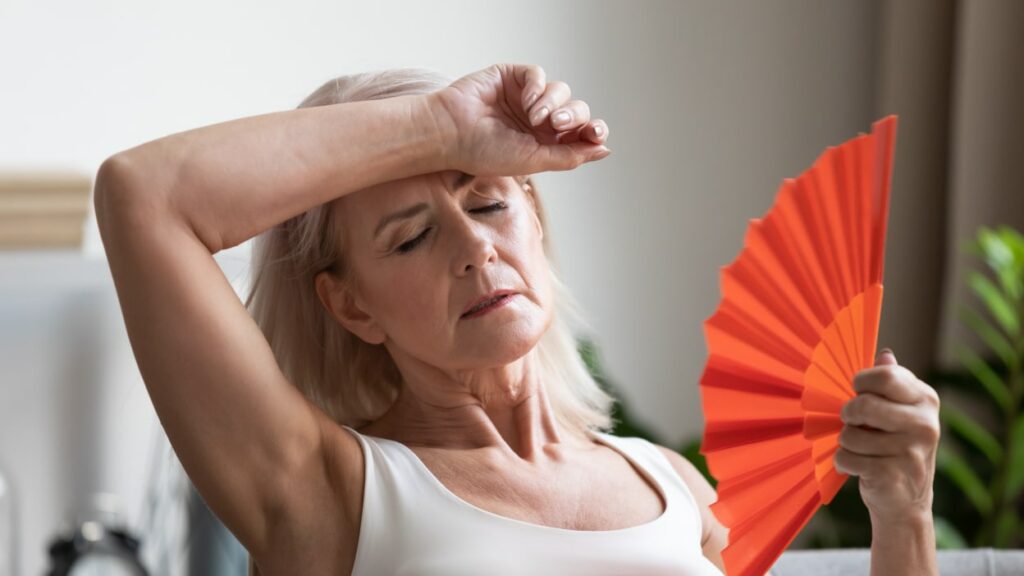As women approach their forties, they often encounter a significant and transformative phase in their lives known as perimenopause. This transitional period, leading up to menopause can bring about a myriad of physical and emotional changes. While some women may experience mild symptoms, others may find perimenopause challenging to navigate. In this blog post, we’ll explore natural treatment for perimenopause, providing insights into holistic approaches that can help manage symptoms and enhance overall well-being.
Contents
What is “Perimenopause”?

Perimenopause, also known as the menopausal transition, is the stage in a woman’s life that occurs before menopause. Menopause is defined as the point when a woman has not had a menstrual period for 12 consecutive months, marking the end of her reproductive years. Perimenopause typically starts several years before menopause and is characterized by hormonal fluctuations and a variety of physical and emotional changes.
During perimenopause, the ovaries gradually reduce their production of estrogen and progesterone, two key hormones involved in the menstrual cycle. This hormonal shift can result in a range of symptoms and changes in the menstrual cycle. Perimenopause can last for an average of four to eight years, but the duration varies for each individual.
Common signs and symptoms of perimenopause include:
- Irregular Menstrual Periods: Menstrual cycles may become irregular, with variations in the length of the cycle and changes in the flow.
- Hot Flashes: Sudden feelings of warmth, often accompanied by redness of the face and upper body, and sometimes followed by sweating and chills.
- Night Sweats: Episodes of excessive sweating during the night that can disrupt sleep.
- Sleep Disturbances: Changes in sleep patterns, including difficulty falling asleep or staying asleep.
- Mood Swings: Fluctuations in mood, including irritability, anxiety, and feelings of sadness.
- Vaginal Changes: Thinning and dryness of the vaginal tissues, which can lead to discomfort during sexual activity.
- Changes in Libido: Some women may experience changes in sexual desire or satisfaction.
- Bone Density Changes: A gradual decline in bone density, which may increase the risk of osteoporosis.
List of 6 Perimenopause Natural Treatments
Here’s a condensed list of 10 natural treatments for perimenopause:
Dietary Changes
Herbal Remedies

Herbal remedies have been used for centuries to address various health concerns, and some women find relief from perimenopausal symptoms through these natural approaches. It’s important to note that individual responses to herbs can vary, and consulting with a healthcare professional before incorporating herbal remedies into your routine is advisable. Here are some herbal remedies that are commonly considered for perimenopause natural treatments:
Black Cohosh (Cimicifuga racemosa):
- Often used to alleviate hot flashes, night sweats, and mood swings.
- May have estrogen-like effects that help balance hormonal fluctuations.
Dong Quai (Angelica sinensis):
- Traditionally used in Chinese medicine to support female reproductive health.
- Believed to have potential benefits for regulating menstrual cycles and reducing symptoms like hot flashes.
Red Clover (Trifolium pratense):
- Contains compounds called isoflavones, which are phytoestrogens.
- May help manage symptoms related to hormonal fluctuations and support bone health.
Chasteberry (Vitex agnus-castus):
- Known for its potential to balance hormones, particularly by influencing the pituitary gland.
- May help alleviate symptoms like breast tenderness and mood swings.
Evening Primrose Oil (Oenothera biennis):
- Contains gamma-linolenic acid (GLA), which may help with hormonal balance.
- Often used for managing symptoms like breast pain and mood swings.
Regular Exercise
Regular exercise is a cornerstone of a healthy lifestyle and can significantly contribute to managing perimenopausal symptoms. Engaging in physical activity has numerous benefits for both physical and mental well-being. Here are ways in which regular exercise can be a natural treatment for perimenopause:
Aerobic Exercises:
- Brisk Walking: A low-impact exercise that can be easily incorporated into daily routines.
- Cycling: Whether outdoors or on a stationary bike, cycling is excellent for cardiovascular health.
- Swimming: A full-body workout that is gentle on the joints and promotes cardiovascular fitness.
- Dancing: A fun and enjoyable way to get the heart rate up while improving flexibility and balance.
Strength Training:
- Weight Lifting: Incorporate resistance training with weights or resistance bands to build and maintain muscle mass.
- Bodyweight Exercises: Include squats, lunges, push-ups, and planks for effective strength training without the need for equipment.
Flexibility and Balance Exercises:
- Yoga: Enhances flexibility, balance, and relaxation. It also has mood-boosting benefits.
- Pilates: Focuses on core strength, flexibility, and overall muscle tone.
- Tai Chi: A gentle, flowing exercise that improves balance, coordination, and mental focus.
Mindfulness and Stress Reduction
Mindfulness and stress reduction techniques can be powerful natural treatments during perimenopause, helping women navigate the physical and emotional changes associated with this transitional phase. Incorporating mindfulness practices into daily life can enhance overall well-being and alleviate symptoms such as mood swings, anxiety, and sleep disturbances. Here are some mindfulness and stress reduction strategies:
- Mindful Meditation: Practice mindfulness meditation to cultivate present-moment awareness. Focus on your breath, sensations, or a specific point of focus, allowing thoughts to come and go without judgment.
- Deep Breathing Exercises: Engage in deep breathing exercises to activate the body’s relaxation response. Try diaphragmatic breathing, inhaling deeply through the nose, expanding the diaphragm, and exhaling slowly through pursed lips.
- Progressive Muscle Relaxation (PMR): PMR involves systematically tensing and then relaxing different muscle groups, promoting physical and mental relaxation. It can help reduce muscle tension and anxiety.
- Yoga: Incorporate yoga into your routine to combine physical postures, breath control, and meditation. Yoga is known for its stress-relieving and mood-enhancing benefits.
- Guided Imagery: Use guided imagery to create calming mental images. Imagine serene landscapes or peaceful scenes, allowing the mind to focus on positive and relaxing visuals.
Adequate Sleep Hygiene

Adequate sleep hygiene is crucial during perimenopause, as hormonal fluctuations and associated symptoms can impact sleep quality. Implementing good sleep habits can contribute to better rest and overall well-being. Here are key strategies for maintaining adequate sleep hygiene as a natural treatment during perimenopause:
- Establish a Consistent Sleep Schedule: Go to bed and wake up at the same time every day, even on weekends. Consistency helps regulate the body’s internal clock.
- Create a Relaxing Bedtime Routine: Develop a calming routine before bedtime to signal to your body that it’s time to wind down. This may include activities like reading a book, taking a warm bath, or practicing relaxation exercises.
- Optimize Sleep Environment: Ensure your bedroom is conducive to sleep. Keep the room cool, dark, and quiet. Consider blackout curtains, earplugs, or a white noise machine to minimize disruptions.
- Invest in a Comfortable Mattress and Pillows: A supportive mattress and comfortable pillows contribute to a restful night’s sleep. Evaluate your sleep surface and make adjustments if necessary.
- Limit Exposure to Screens Before Bed: Reduce exposure to electronic devices with screens (phones, tablets, computers) at least an hour before bedtime. The blue light emitted from screens can interfere with the production of the sleep hormone melatonin.
Essential Oils
Why Do People Prefer Perimenopause Natural Treatment?

People may prefer natural treatments for perimenopause for various reasons, and the decision to pursue natural options often stems from a combination of factors. Here are several reasons why individuals may choose perimenopause natural treatments:
- Minimization of Side Effects: Natural treatments, such as lifestyle changes, dietary adjustments, and herbal remedies, are often perceived as having fewer side effects compared to pharmaceutical interventions. This can be appealing to those who wish to minimize potential risks and complications.
- Holistic Approach: Natural treatments often embrace a holistic approach, addressing multiple aspects of well-being rather than targeting specific symptoms in isolation. This approach aligns with the idea of treating the whole person rather than just the symptoms.
- Patient Empowerment: Choosing natural treatments allows individuals to actively participate in their health and well-being. Lifestyle modifications, dietary changes, and mindfulness practices empower individuals to take control of their health during perimenopause.
- Prevention of Long-Term Health Risks: Some natural treatments, such as dietary changes and regular exercise, not only alleviate perimenopausal symptoms but also contribute to long-term health. For example, maintaining a healthy weight and exercising regularly can reduce the risk of osteoporosis, cardiovascular issues, and other health concerns associated with aging.
Conclusion
In conclusion, perimenopause natural treatments offer a holistic and patient-centered approach, emphasizing lifestyle changes, dietary modifications, and complementary therapies. With a focus on minimizing side effects and empowering individuals to actively participate in their well-being, these approaches address the multifaceted challenges of perimenopause. Whether driven by a desire for personalized care, cultural beliefs, or concerns about conventional treatments, the preference for natural interventions reflects a growing awareness of the interconnectedness of lifestyle and health.
It is essential, however, to consult with healthcare professionals to ensure safety and effectiveness, fostering a balanced and informed approach to managing perimenopausal experiences. If you are facing menopause-related issues, menopause treatment at HerMantra can help. Book your free trial online menopause treatment session now.


